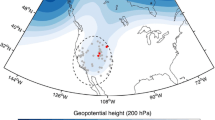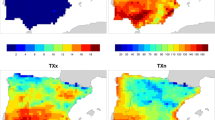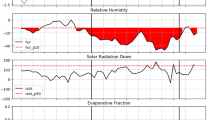Abstract
We assess the occurrence and probability of extreme heat over Australia in association with the Southern Annular Mode (SAM), persistent anticyclones over the Tasman Sea, and the Madden–Julian Oscillation (MJO), which have previously been shown to be key drivers of intra-seasonal variations of Australian climate. In this study, extreme heat events are defined as occurring when weekly-mean maximum temperature anomalies exceed the 90th percentile. The observed probability of exceedance is reduced during the positive phase of the SAM and enhanced during the negative phase of the SAM over most of Australia. Persistent anticyclones over the Tasman Sea are described in terms of (1) split-flow blocking at 160°E and (2) high pressure systems located in the vicinity of the subtropical ridge (STRHs), about 10° north of the split-flow blocking region, for which we devise a simple index. Split-flow blocks and STRHs have contrasting impacts on the occurrence of extreme heat over Australia, with STRHs showing enhanced probability of upper decile heat events over southern Australia in all seasons. The observed probability of an upper decile heat event varies according to MJO phase and time of year, with the greatest impact of the MJO on extreme heat occurring over southern Australia (including the Mallee agricultural region) in spring during phases 2–3. We show that this modulation of the probability of extreme heat by the SAM, persistent anticyclones over the Tasman Sea, and the MJO is well simulated in the Bureau of Meteorology dynamical intra-seasonal/seasonal forecast model POAMA-2 at lead times of 2–3 weeks. We further show that predictability of heat extremes increases in association with the negative SAM phase, STRH and MJO, thus providing a basis for skilful intra-seasonal prediction of heat extremes.













Similar content being viewed by others
References
Alexander LV, Arblaster JM (2009) Assessing trends in observed and modelled climate extremes over Australia in relation to future projections. Int J Climatol 29:417–435
Alexander LV, Hope P, Collins D, Trewin B, Lynch A, Nicholls N (2007) Trends in Australia’s climate means and extremes: a global context. Aust Met Mag 56:1–18
Alexander LV, Uotila P, Nicholls N (2009) Influence of sea surface temperature variability on global temperature and precipitation extremes. J Geophys Res 114:D18116. doi:10.1029/2009JD012301
Alves O, Wang G, Zhong A, Smith N, Tzeitkin F, Warren G, Schiller A, Godfrey S, Meyers G (2003) POAMA: bureau of meteorology operational coupled model forecast system. In: Proceedings of national drought forum, Brisbane, April 2003, pp 49-56. Available from DPI Publications, Department of Primary Industries, GPO Box 46, Brisbane, Qld 4001, Australia
Arblaster JM, Alexander LV (2012) The impact of the El Niño-southern oscillation on maximum temperature extremes. Geophys Res Lett 39:L20702. doi:10.1029/2012GL053409
Barnston AG, Mason SJ (2011) Evaluation of IRI’s seasonal climate forecasts for the extreme 15 % tails. Weather Forecast 26:545–554
Barriopedro D, Fischer EM, Luterbacher J, Trigo RM, García-Herrera R (2011) The hot summer of 2010: redrawing the temperature record map of Europe. Science 332:220–224
Becker EJ, van den Dool H, Peña M (2013) Short-term climate extremes: prediction skill and predictability. J Clim 26:512–531
Black E, Blackburn M, Harrison G, Hoskins B, Methven J (2004) Factors contributing to the summer 2003 European heatwave. Weather 59:217–223
Casati B, Wilson LJ, Stephenson DB, Nurmi P, Ghelli A, Pocernich M, Damrath U, Ebert EE, Brown BG, Mason S (2008) Forecast verification: current status and future directions. Meteorol Appl 15:3–18
Charney JG, DeVore JG (1979) Multiple flow equilibria in the atmosphere and blocking. J Atmos Sci 36:1205–1216
Coates L (1996) An overview of fatalities from some natural hazards in Australia. In Proceedings of NDR96 conference on natural disaster reduction. Gold Coast Australia
Collins DA, Della-Marta PM, Plummer N, Trewin BC (2000) Trends in annual frequencies of extreme temperature events in Australia. Aust Met Mag 49:277–292
Colman R, Deschamps L, Naughton M, Rikus L, Sulaiman A, Puri K, Roff G, Sun Z, Embury G (2005) BMRC atmospheric model (BAM) version3.0: comparison with mean climatology. BMRC research report no. 108, Bur Met, Melbourne, Australia
Coughlan M (1983) A comparative climatology of blocking action in the two hemispheres. Aust Met Mag 31:3–13
Coumou D, Rahmstorf S (2012) A decade of weather extremes. Nat Clim Change 2:491–496
De Bono A, Giuliani G, Kluser S, Peduzzi P (2004) Impacts of summer 2003 heat wave in Europe. UNEP/DEWA/GRID Eur Environ Alert Bull 2:1–4
Ferro CAT, Stephenson DB (2011) Extremal dependence indices: improved verification measures for deterministic forecasts of rare binary events. Weather Forecast 26:699–713
Fischer EM, Seneviratne SI, Luthi D, Schär C (2007) Contribution of land-atmosphere coupling to recent European summer heat waves. Geophys Res Lett 34:L06707. doi:10.1029/2006GL029068
Fouillet A, Rey G, Laurent F, Pavillon G, Bellec S, Guihenneuc-Jouyaux C, Clavel J, Jougla E, He′mon D (2006) Excess mortality related to the August 2003 heat wave in France. Int Arch Occup Environ Health 80:16–24
Frederiksen CS, Zheng X (2007) Variability of seasonal-mean fields arising from intraseasonal variability. Part 3: application to SH winter and summer circulations. Clim Dyn 28:849–866
Gilbert N (2010) Russia counts environmental cost of wildfires. Nat News 12 Aug. doi:10.1038/news.2010.404
Grainger S, Frederiksen CS, Zheng X (2013) Modes of interannual variability of Southern Hemisphere atmospheric circulation in CMIP3 models: assessment and projections. Clim Dyn 41:479–500
Griffiths GM, Chambers LE, Haylock MR, Manton MJ, Nicholls N, Baek H-J, Choi Y, Della-Marta PM, Gosai A, Iga N, Lata R, Laurent V, Maitrepierre L, Nakamigawa H, Ouprasitwong N, Solofa D, Tahani L, Thuy DT, Tibig L, Trewin B, Vediapan K, Zhai P (2005) Change in mean temperature as a predictor of extreme temperature change in the Asia-Pacific region. Int J Climatol 25:1301–1330
Hamilton E, Eade R, Graham RJ, Scaife AA, Smith DM, Maidens A, MacLachlan C (2012) Forecasting the number of extreme daily events on seasonal timescales. J Geophys Res 117:D03114. doi:10.1029/2011JD016541
Hendon HH, Thompson DWJ, Wheeler MC (2007) Australian rainfall and surface temperature variations associated with the southern hemisphere annular mode. J Clim 20:2452–2467
Hendon HH, Lim E-P, Liu G (2012) The role of air-sea interaction for prediction of Australian summer monsoon rainfall. J Clim 25:1278–1290
Hendon HH, Lim E-P, Arblaster JM, Anderson DLT (2013) Causes and predictability of the record wet east Australian spring 2010. Clim Dyn. doi:10.1007/s00382-013-1700-5
Hogan RJ, Mason IB (2012) Deterministic forecasts of binary events. In Jolliffe IT, Stephenson DB (eds) Forecast verification: a practitioner’s guide in atmospheric science, 2nd edn. Wiley doi:10.1002/9781119960003.ch3
Hudson D, Marshall AG, Alves O (2011a) Intraseasonal forecasting of the 2009 summer and winter Australian heat waves using POAMA. Weather Forecast 26:257–279
Hudson D, Alves O, Hendon HH, Wang G (2011b) The impact of atmospheric initialisation on seasonal prediction of tropical Pacific SST. Clim Dyn 36:1155–1171
Hudson D, Marshall A, Yin Y, Alves O, Hendon H (2013) Improving intraseasonal prediction with a new ensemble generation strategy. Mon Weather Rev. doi:10.1175/MWR-D-13-00059.1
IPCC (2007) Climate change 2007: the physical science basis. In: Solomon S, Qin D, Manning M, Chen Z, Marquis M, Averyt KB, Tignor M, Miller HL (eds) Contribution of working group i to the fourth assessment report of the intergovernmental panel on climate change. Cambridge University Press, 996 pp
Jones PA (1991) Historical records of cloud cover and climate for Australia. Aust Meteor Mag 39:181–189
Jones DA, Trewin BC (2000) On the relationships between the El Niño-Southern Oscillation and Australian land surface temperature. Int J Climatol 20:697–719
Jones DA, Wang W, Fawcett R (2009) High-quality spatial climate data-sets for Australia. Aust Meteorol Oceanogr J 58:233–248
Kalnay E, Kanamitsu M, Kistler R, Collins W, Deaven D, Gandin L, Iredell M, Saha S, White G, Woollen J, Zhu Y, Leetmaa A, Reynolds B, Chelliah M, Ebisuzaki W, Higgins W, Janowiak J, Mo KC, Ropelewski C, Wang J, Jenne R, Joseph D (1996) The NCEP/NCAR 40-year reanalysis project. Bull Am Meteorol Soc 77:437–471
Karl TR, Knight RW (1997) The 1995 Chicago heatwave: how likely is a recurrence? Bull Amer Meteor Soc 78:1107–1119
Karoly DJ (2009) The recent bushfires and extreme heatwave in southeast Australia. Bull Aust Meteor Oceanogr Soc 22:10–13
Kenyon J, Hegerl GC (2008) Influence of modes of climate variability on global temperature extremes. J Clim 21:3872–3889
Kharin VV, Zwiers FW, Zhang XB, Hegerl GC (2007) Changes in temperature and precipitation extremes in the IPCC ensemble of global coupled model simulations. J Clim 20:1419–1444
Kysely J (2009) Recent severe heat waves in central Europe: how to view them in a long-term prospect? Int J Clim 30:89–109. doi:10.1002/joc.1874
Lim E-P, Hendon HH, Rashid H (2013) Seasonal predictability of the Southern Annular Mode due to its association with ENSO. J Clim 26:8037–8054
Madden RA, Julian PR (1971) Detection of a 40–50 day oscillation in the zonal wind in the tropical Pacific. J Atmos Sci 28:702–708
Madden RA, Julian PR (1972) Description of global-scale circulation cells in the tropics with a 40–50 day period. J Atmos Sci 29:1109–1123
Manabe S, Holloway JL (1975) The seasonal variation of the hydrological cycle as simulated by a global model of the atmosphere. J Geophys Res 80:1617–1649
Marshall AG, Hudson D, Wheeler MC, Hendon HH, Alves O (2012a) Simulation and prediction of the Southern Annular Mode and its influence on Australian intra-seasonal climate in POAMA. Clim Dyn 38:2483–2502
Marshall AG, Hudson D, Wheeler MC, Hendon HH, Alves O (2012b) Evaluating key drivers of Australian intra-seasonal climate variability in POAMA-2: a progress report. CAWCR Res Lett 7:10–16
Marshall AG, Hudson D, Hendon HH, Pook MJ, Alves O, Wheeler MC (2013) Simulation and prediction of blocking in the Australian region and its influence on intra-seasonal rainfall in POAMA-2. Clim Dyn. doi:10.1007/s00382-013-1974-7
Matsueda M (2011) Predictability of Euro-Russian blocking in summer of 2010. Geophys Res Lett 38:L06801. doi:10.1029/2010GL046557
Min S-K, Cai W, Whetton P (2013) Influence of climate variability on seasonal extremes over Australia. J Geophys Res Atmos 118:643–654
Nairn J, Fawcett R (2013) Defining heatwaves: heatwave defined as a heat-impact event servicing all community and business sectors in Australia. CAWCR Tech Rep No 60, 96 pp
Nicholls N, Drosdowsky W, Lavery B (1997) Australian rainfall variability and change. Weather 52:66–72
Nordeng T-E (1994) Extended versions of the convective parameterization scheme at ECMWF and their impact upon the mean climate and transient activity of the model in the tropics. Research Dept Technical Memorandum No. 206, ECMWF, Shinfield Park Reading RG2 9AX, United Kingdom
Oke PR, Schiller A, Griffin DA, Brassington GB (2005) Ensemble data assimilation for an eddy-resolving ocean model of the Australian region. Q J R Meteorol Soc 131:3301–3311
Perkins SE, Alexander LV (2013) On the measurement of heat waves. J Clim 26:4500–4517
Perkins SE, Alexander LV, Nairn JR (2012) Increasing frequency, intensity and duration of observed heatwaves and warm spells. Geophys Res Lett 39:L20714. doi:10.1029/2012GL053361
Pezza AB, van Rensch P, Cai W (2012) Severe heat waves in Southern Australia: synoptic climatology and large scale connections. Clim Dyn 38:209–224
Plummer N, Salinger MJ, Nicholls N, Suppiah R, Hennessy KJ, Leighton RM, Trewin B, Page CM, Lough JM (1999) Changes in climate extremes over the Australian region and New Zealand during the twentieth century. Clim Change 42:183–202
Pook MJ, Gibson T (1999) Atmospheric blocking and storm tracks during SOP-1 of the FROST Project. Aust Meteor Mag 48:51–60
Power S, Tseitkin F, Torok SJ, Lavery B, Dahni R, McAvaney B (1998) Australian temperature, Australian rainfall and the Southern Oscillation, 1910–1992: coherent variability and recent changes’. Aust Meteor Mag 47:85–101
Rahmstorf S, Coumou D (2011) Increase of extreme events in a warming world. Proc Natl Acad Sci USA 108:17905–17909
Risbey JS, Pook MJ, McIntosh PC, Wheeler MC, Hendon HH (2009) On the remote drivers of rainfall variability in Australia. Mon Weather Rev 137:3233–3253
Schiller A., Godfrey JS, McIntosh P, Meyers G (1997) A global ocean general circulation model climate variability studies. CSIRO Marine research report no 227
Schiller A, Godfrey JS, McIntosh PC, Meyers G, Smith NR, Alves O, Wang G, Fiedler R (2002) A new version of the australian community ocean model for seasonal climate prediction. CSIRO marine research report no. 240
Spiegel MR (1961) Schaum’s outline of theory and problems of statistics. Schaum Publishing Company, New York, 359 pp
Stockdale TN (1997) Coupled ocean–atmosphere forecasts in the presence of climate drift. Mon Weather Rev 125:809–818
Tiedke M (1989) A comprehensive mass flux scheme for cumulus parameterisation in large-scale models. Mon Weather Rev 117:1779–1800
Trigo R, Garia-Herrera R, Diaz J, Trigo I, Valente M (2005) How exceptional was the early August 2003 heatwave in France? Geophys Res Lett 32:1071–1074
Uppala SM et al (2005) The ERA-40 re-analysis. Q J R Meteorol Soc 131:2961–3012
Valcke S, Terray L, Piacentini A (2000) OASIS 2.4 Ocean Atmospheric Sea Ice Soil user’s guide, Version 2.4. CERFACS technical report, CERFACS TR/CMGC/00-10, 85 pp
Wang G, Alves O, Smith N (2005) BAM3.0 tropical surface flux simulation and its impact on SST drift in a coupled model. BMRC Research Report No. 107, Bur Met Australia
Wang Y, Kowalczyk E, Law R, Abramowitz G (2006) The CSIRO Atmosphere Biosphere Land Exchange Model and future development for ACCESS. BMRC Research Report No. 123, Bur Met Australia
Wheeler MC, Hendon HH (2004) An all-season real-time multivariate MJO index: development of an index for monitoring and prediction. Mon Weather Rev 132:1917–1932
Wheeler MC, Hendon HH, Cleland S, Meinke H, Donald A (2009) Impacts of the Madden–Julian oscillation on Australian rainfall and circulation. J Clim 22:1482–1498
Yin Y, Alves O, Oke PR (2011) An ensemble ocean data assimilation system for seasonal prediction. Mon Weather Rev 139:786–808
Zhong A, Alves O, Hendon H, Rikus L (2006) On aspects of the mean climatology and tropical interannual variability in the BMRC atmospheric model (BAM 3.0). BMRC research report no. 121, Bur Met, Melbourne, Australia
Acknowledgments
This work was supported by the Managing Climate Variability Program of Grains Research and Development Corporation. We extend our thanks to Peter McIntosh and the two anonymous reviewers for generously giving their time to help improve the overall quality of this paper.
Author information
Authors and Affiliations
Corresponding author
Rights and permissions
About this article
Cite this article
Marshall, A.G., Hudson, D., Wheeler, M.C. et al. Intra-seasonal drivers of extreme heat over Australia in observations and POAMA-2. Clim Dyn 43, 1915–1937 (2014). https://doi.org/10.1007/s00382-013-2016-1
Received:
Accepted:
Published:
Issue Date:
DOI: https://doi.org/10.1007/s00382-013-2016-1




